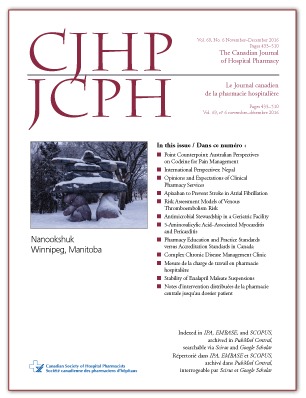5-Aminosalicylic Acid–Associated Myocarditis and Pericarditis: A Narrative Review
DOI:
https://doi.org/10.4212/cjhp.v69i6.1610Keywords:
5-aminosalicylic acid, mesalamine, mesalazine, myocarditis, pericarditis, acide 5-aminosalicylique, mésalamine, mésalazine, myocardite, péricarditeAbstract
ABSTRACT
Background: Use of medications containing the 5-aminosalicylic acid (5-ASA) moiety may cause a rare but potentially lethal side effect involving inflammation of the heart (myocarditis) or pericardium (pericarditis) or both (myopericarditis). Early recognition of 5-ASA as the cause is important to prevent progression of the inflammation.
Objective: To provide clinicians with information to assist in recognizing the signs and symptoms of 5-ASA–induced cardiac inflammation and the characteristics of the suspected therapy, and in determining the appropriate approach to treatment.
Data Sources, Study Selection, and Data Extraction: The Embase database was searched, for the period 1974 to July 17, 2015, for published descriptions of cases of cardiac inflammation caused by 5-ASA–containing medications. The search terms included the names of specific agents, as well as terms for different types of cardiac inflammation. Articles in any language were retained for inclusion in this narrative review.
Findings: There is no symptom, sign, laboratory test, or constellation of symptoms and signs that is pathognomonic for 5-ASA–induced myocardial–pericardial toxicity. Similarly, there is no single laboratory, electrocardiographic, or echocardiographic finding or combination of findings that implicates 5-ASA as the cause of nonspecific symptoms. However, most patients present with chest pain, shortness of breath, and fever within the first 28 days after initiating 5-ASA. Physical examination, electrocardiography, and diagnostic imaging will yield findings consistent with myocarditis, with or without accompanying pericarditis. Prompt discontinuation of the 5-ASA will result in resolution of symptoms within days, without the need for any adjunctive therapies. Rechallenge with any 5-ASA–containing compound carries a high risk for recurrence of the
inflammation.
Conclusions: Any patient presenting with chest pain, shortness of breath, or fever within 28 days after initiating a 5-ASA–containing drug should be considered as exhibiting drug-induced inflammation. The 5-ASA–containing drug should be stopped immediately until other causes can be proven (or excluded); if no other cause is discovered, the 5-ASA should not be restarted.
RÉSUMÉ
Contexte : L’emploi de médicaments à base d’acide 5-aminosalicylique (5-AAS) peut causer un effet indésirable rare, mais potentiellement mortel qui se traduit par l’inflammation du myocarde (myocardite) ou du péricarde (péricardite) ou de ces deux éléments du système cardiaque (myopéricardite). Il est important d’établir rapidement que l’inflammation est imputable à l’AAS afin de prévenir la progression de cet effet indésirable.
Objectif : Fournir aux cliniciens de l’information les aidant à reconnaître les signes et symptômes d’une inflammation cardiaque causée par le 5-AAS et les caractéristiques de la thérapie soupçonnée ainsi qu’à déterminer l’approche thérapeutique adéquate.
Sources des données, sélection des études et extraction des données : La base de données Embase a été interrogée, pour la période allant de 1974 au 17 juillet 2015, afin de trouver des descriptions publiées de cas d’inflammation cardiaque causée par des médicaments contenant du 5-AAS. Les termes utilisés pour la recherche comprenaient les noms d’agents précis ainsi que les termes désignant différents types d’inflammation cardiaque. La langue n’était pas un critère pour l’admissibilité des articles à la présente revue narrative.
Résultats : Il n’y a pas de symptôme, de signe, d’examen de laboratoire ou de cortège de symptômes et de signes qui soit pathognomonique d’une toxicité myocardique ou péricardique causée par le 5-AAS. De même, il n’y a pas de résultat de laboratoire, d’électrocardiogramme ou d’échocardiogramme, seul ou en association, qui puisse attribuer la cause de symptômes non spécifiques au 5-AAS. Cependant, la plupart des patients présentent des douleurs thoraciques, une dyspnée et de la fièvre au cours des 28 premiers jours suivant l’amorce du traitement par le 5-AAS. L’examen physique, l’électrocardiographie et l’imagerie diagnostique permettent d’obtenir des résultats qui indiquent une myocardite, avec ou sans péricardite. L’interruption rapide du traitement par le 5-AAS permet la disparition des symptômes en quelques jours, sans avoir à recourir à un traitement d’appoint. La réintroduction de toute préparation à base de 5-AAS comporte un risque élevé de récurrence de l’inflammation.
Conclusions : Tout patient affichant des douleurs thoraciques, de la dyspnée ou de la fièvre dans les 28 jours suivant l’amorce d’un traitement avec une préparation contenant du 5-AAS doit être considéré comme présentant une inflammation causée par un médicament. Il faut interrompre immédiatement le traitement par le 5-AAS jusqu’à ce que d’autres causes puissent être confirmées ou infirmées. Si l’on ne trouve pas d’autre cause aux symptômes, le traitement par le 5-AAS ne doit pas être recommencé.
Downloads
Published
Issue
Section
License
Copyright © Canadian Society of Healthcare-Systems Pharmacy.
After publication of a manuscript in the CJHP, the authors of the manuscript must obtain written permission from the CSHP (publications@cshp.ca) before reproducing any text, figures, tables, or illustrations from the work in future works of their own. If a submitted manuscript is declined for publication in the CJHP, all said rights shall revert to the authors. Please note that any forms (e.g., preprinted orders and patient intake forms) used by a specific hospital or other health care facility and included as illustrative material with a manuscript are exempt from this copyright transfer. The CJHP will require a letter from the hospital or health care facility granting permission to publish the document(s).










